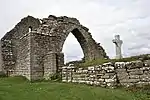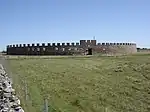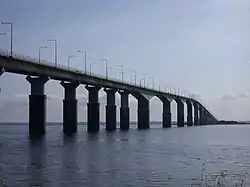Mörbylånga Municipality
Mörbylånga kommun | |
|---|---|
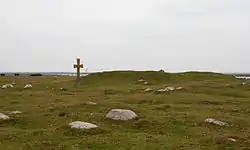 | |
 Coat of arms | |
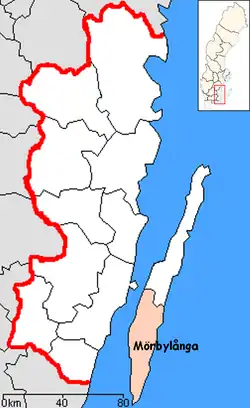 | |
| Coordinates: 56°31′N 16°23′E / 56.517°N 16.383°E | |
| Country | Sweden |
| County | Kalmar County |
| Seat | Mörbylånga |
| Area | |
| • Total | 3,043.42 km2 (1,175.07 sq mi) |
| • Land | 666.79 km2 (257.45 sq mi) |
| • Water | 2,376.63 km2 (917.62 sq mi) |
| Area as of 1 January 2014. | |
| Population (31 December 2021)[2] | |
| • Total | 15,722 |
| • Density | 5.2/km2 (13/sq mi) |
| Time zone | UTC+1 (CET) |
| • Summer (DST) | UTC+2 (CEST) |
| ISO 3166 code | SE |
| Province | Öland |
| Municipal code | 0840 |
| Website | www.morbylanga.se |
Mörbylånga Municipality (Mörbylånga kommun) is a municipality in Kalmar County, in south-eastern Sweden, located on the island of Öland in the Baltic Sea. The seat is located in the town of Mörbylånga, while the largest town is Färjestaden.
The present municipality, making up the southern part of Öland, was formed in 1974. The eighteen original entities (as of 1863) had during the nationwide subdivision reform of 1952 been regrouped into three larger units. Ottenby was amalgamated with Mörbylånga in 1967 and 1974 Torslunda was added.
Mörbylånga Municipality contains several ancient remains, just like the northern Öland municipality of Borgholm. All in all, there are about 20 hillforts on Öland. The most notable in southern Öland is the fortress Eketorp.
The southern parts of Öland contain certain wildlife areas. Many migratory birds halt here on their way north or south. Especially the southernmost outpost, the lighthouse Långe Jan (Tall John) is visited by many birdwatchers every day, as many birds flock here until setting away over the ocean.
Localities
There are 9 urban areas (also called a Tätort or locality) in Mörbylånga Municipality.
In the table the localities are listed according to the size of the population as of December 31, 2005. The municipal seat is in bold characters.
| # | Locality | Population |
|---|---|---|
| 1 | Färjestaden | 4,636 |
| 2 | Mörbylånga | 1,784 |
| 3 | Skogsby | 528 |
| 4 | Algutsrum | 499 |
| 5 | Degerhamn | 372 |
| 6 | Vickleby | 310 |
| 7 | Gårdby | 262 |
| 8 | Arontorp | 231 |
| 9 | Kastlösa | 208 |
Demographics
This is a demographic table based on Mörbylånga Municipality's electoral districts in the 2022 Swedish general election sourced from SVT's election platform, in turn taken from SCB official statistics.[3]
Residents include everyone registered as living in the district, regardless of age or citizenship status. Valid voters indicate Swedish citizens above the age of 18 who therefore can vote in general elections. Left vote and right vote indicate the result between the two major blocs in said district in the 2022 general election. Employment indicates the share of people between the ages of 20 and 64 who are working taxpayers. Foreign background is defined as residents either born abroad or with two parents born outside of Sweden. Median income is the received monthly income through either employment, capital gains or social grants for the median adult above 20, also including pensioners in Swedish kronor. The section about college graduates indicates any degree accumulated after high school.
In total there were 15,717 inhabitants, with 12,229 Swedish citizens of voting age.[3] 46.1 % voted for the left coalition and 53.1 % for the right coalition.
| Location | Residents | Valid voters | Left vote | Right vote | Employed | SV parents | 1st/2nd gen | Income | College |
|---|---|---|---|---|---|---|---|---|---|
| % | % | % | % | % | % | ||||
| Algutsrum | 1,702 | 1,269 | 41.6 | 57.6 | 90 | 94 | 6 | 28,739 | 46 |
| Glömminge | 673 | 537 | 40.6 | 58.4 | 87 | 94 | 6 | 27,400 | 47 |
| Gårdby | 1,495 | 1,176 | 48.2 | 51.4 | 88 | 95 | 5 | 23,869 | 38 |
| Mörbylånga-Kastlösa | 2,225 | 1,781 | 53.7 | 45.3 | 80 | 82 | 18 | 22,923 | 35 |
| Runsbäck | 2,505 | 1,839 | 46.8 | 52.6 | 88 | 91 | 9 | 27,866 | 45 |
| Skogsby | 1,884 | 1,449 | 44.6 | 54.7 | 86 | 91 | 9 | 27,331 | 48 |
| Snäckstrand | 1,804 | 1,422 | 42.0 | 57.6 | 87 | 92 | 8 | 28,633 | 46 |
| Sydöland | 967 | 849 | 46.9 | 52.4 | 75 | 86 | 14 | 21,700 | 35 |
| Talludden | 1,559 | 1,178 | 45.8 | 53.4 | 82 | 85 | 15 | 23,450 | 39 |
| Vickleby-Resmo | 903 | 729 | 48.0 | 50.6 | 81 | 93 | 7 | 27,913 | 56 |
| Source: SVT[3] | |||||||||
Elections
Riksdag
These are the results of the elections to the Riksdag since the first election after the municipal reform that was held in 1973. The results only include parties that have won representation in the Riksdag assembly at least once during this timeframe. The results of the Sweden Democrats were not listed at a municipal level by the SCB between 1988 and 1998 due to the party's small size at the time. "Turnout" denotes the number of voters who cast a ballot in the polling station, but "Votes" only counts those casting valid ballots.
| Year | Turnout | Votes | V | S | MP | C | L | KD | M | SD | ND |
|---|---|---|---|---|---|---|---|---|---|---|---|
| 1973[4] | 92.0 | 6,857 | 1.8 | 34.3 | 0.0 | 39.2 | 6.8 | 1.0 | 16.8 | 0.0 | 0.0 |
| 1976[5] | 92.6 | 7,915 | 1.8 | 35.2 | 0.0 | 35.8 | 7.9 | 0.6 | 18.6 | 0.0 | 0.0 |
| 1979[6] | 92.3 | 8,341 | 2.7 | 34.6 | 0.0 | 30.1 | 8.4 | 0.8 | 23.3 | 0.0 | 0.0 |
| 1982[7] | 92.2 | 8,488 | 2.1 | 37.1 | 1.3 | 27.2 | 4.9 | 1.2 | 26.2 | 0.0 | 0.0 |
| 1985[8] | 90.7 | 8,463 | 2.2 | 36.5 | 1.3 | 24.3 | 11.4 | 0.0 | 24.2 | 0.0 | 0.0 |
| 1988[9] | 87.7 | 8,298 | 2.7 | 37.8 | 4.4 | 24.6 | 8.9 | 2.2 | 19.0 | 0.0 | 0.0 |
| 1991[10] | 88.9 | 8,812 | 2.6 | 31.7 | 3.0 | 19.2 | 6.4 | 6.4 | 21.1 | 0.0 | 8.8 |
| 1994[11] | 87.4 | 8,848 | 4.2 | 40.3 | 5.1 | 17.1 | 5.2 | 3.4 | 22.3 | 0.0 | 1.5 |
| 1998[12] | 83.5 | 8,303 | 9.4 | 32.5 | 4.8 | 11.5 | 3.1 | 15.6 | 21.5 | 0.0 | 0.0 |
| 2002[13] | 82.9 | 8,410 | 6.3 | 37.7 | 3.8 | 13.1 | 10.4 | 12.0 | 15.3 | 0.6 | 0.0 |
| 2006[14] | 85.5 | 8,757 | 4.1 | 34.9 | 4.2 | 13.3 | 6.0 | 7.2 | 25.2 | 3.0 | 0.0 |
| 2010[15] | 87.9 | 9,490 | 4.3 | 28.2 | 6.3 | 11.0 | 5.8 | 6.5 | 31.2 | 5.9 | 0.0 |
| 2014[16] | 90.3 | 10,127 | 3.8 | 29.4 | 5.5 | 9.7 | 4.1 | 4.5 | 24.8 | 15.2 | 0.0 |
| 2018[17] | 91.7 | 10,367 | 5.9 | 27.1 | 4.0 | 11.2 | 3.9 | 7.3 | 18.5 | 20.6 | 0.0 |
Blocs
This lists the relative strength of the socialist and centre-right blocs since 1973, but parties not elected to the Riksdag are inserted as "other", including the Sweden Democrats results from 1988 to 2006, but also the Christian Democrats pre-1991 and the Greens in 1982, 1985 and 1991. The sources are identical to the table above. The coalition or government mandate marked in bold formed the government after the election. New Democracy got elected in 1991 but are still listed as "other" due to the short lifespan of the party. "Elected" is the total number of percentage points from the municipality that went to parties who were elected to the Riksdag.
| Year | Turnout | Votes | Left | Right | SD | Other | Elected |
|---|---|---|---|---|---|---|---|
| 1973 | 92.0 | 6,857 | 36.1 | 62.8 | 0.0 | 1.1 | 98.9 |
| 1976 | 92.6 | 7,915 | 37.0 | 62.3 | 0.0 | 0.7 | 99.3 |
| 1979 | 92.3 | 8,341 | 37.3 | 61.8 | 0.0 | 0.9 | 99.1 |
| 1982 | 92.2 | 8,488 | 39.2 | 58.3 | 0.0 | 2.5 | 97.5 |
| 1985 | 90.7 | 8,463 | 38.7 | 59.9 | 0.0 | 1.4 | 98.6 |
| 1988 | 87.7 | 8,298 | 44.9 | 52.5 | 0.0 | 2.6 | 97.4 |
| 1991 | 88.9 | 8,812 | 34.3 | 53.1 | 0.0 | 12.6 | 96.2 |
| 1994 | 87.4 | 8,848 | 49.6 | 48.0 | 0.0 | 2.4 | 97.6 |
| 1998 | 83.5 | 8,303 | 46.7 | 51.7 | 0.0 | 1.6 | 98.4 |
| 2002 | 82.9 | 8,410 | 47.8 | 50.8 | 0.0 | 1.4 | 98.4 |
| 2006 | 85.5 | 8,757 | 43.2 | 51.7 | 0.0 | 5.1 | 94.9 |
| 2010 | 87.9 | 9,490 | 38.8 | 54.5 | 5.9 | 0.8 | 99.2 |
| 2014 | 90.3 | 10,127 | 38.7 | 43.1 | 15.2 | 3.0 | 97.0 |
| 2018 | 91.7 | 10,367 | 37.1 | 41.0 | 20.6 | 1.4 | 98.6 |
Mörbylånga and surroundings
References
- ↑ "Statistiska centralbyrån, Kommunarealer den 1 januari 2014" (in Swedish). Statistics Sweden. 2014-01-01. Archived from the original (Microsoft Excel) on 2016-09-27. Retrieved 2014-04-18.
- ↑ "Folkmängd i riket, län och kommuner 31 december 2021" (in Swedish). Statistics Sweden. February 22, 2022. Retrieved February 22, 2022.
- 1 2 3 "Valresultat 2022 för Mörbylånga i riksdagsvalet" (in Swedish). SVT. 11 September 2022. Retrieved 31 December 2023.
- ↑ "Riksdagsvalet 1973 (page 163)" (PDF) (in Swedish). SCB. Retrieved 26 August 2017.
- ↑ "Riksdagsvalet 1976 (page 158)" (PDF) (in Swedish). SCB. Retrieved 26 August 2017.
- ↑ "Riksdagsvalet 1979 (page 182)" (PDF) (in Swedish). SCB. Retrieved 26 August 2017.
- ↑ "Riksdagsvalet 1982 (page 183)" (PDF) (in Swedish). SCB. Retrieved 26 August 2017.
- ↑ "Riksdagsvalet 1985 (page 184)" (PDF) (in Swedish). SCB. Retrieved 26 August 2017.
- ↑ "Riksdagsvalet 1988 (page 164)" (PDF) (in Swedish). SCB. Retrieved 26 August 2017.
- ↑ "Riksdagsvalet 1991 (page 24)" (PDF) (in Swedish). SCB. Retrieved 26 August 2017.
- ↑ "Riksdagsvalet 1994 (page 38)" (PDF) (in Swedish). SCB. Retrieved 26 August 2017.
- ↑ "Riksdagsvalet 1998 (page 35)" (PDF) (in Swedish). SCB. Retrieved 26 August 2017.
- ↑ "Valresultat Riksdag Mörbylånga kommun 2002" (in Swedish). Valmyndigheten. Retrieved 26 August 2017.
- ↑ "Valresultat Riksdag Mörbylånga kommun 2006" (in Swedish). Valmyndigheten. Retrieved 26 August 2017.
- ↑ "Valresultat Riksdag Mörbylånga kommun 2010" (in Swedish). Valmyndigheten. Retrieved 26 August 2017.
- ↑ "Valresultat Riksdag Mörbylånga kommun 2014" (in Swedish). Valmyndigheten. Retrieved 26 August 2017.
- ↑ "Valresultat Riksdag Mörbylånga kommun 2018" (in Swedish). Valmyndigheten. Retrieved 28 May 2019.
External links
- Mörbylånga Municipality - Official site
- Southern Öland - Tourism page (in Swedish, English and German)
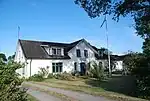
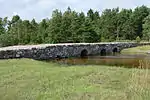
_0501.jpg.webp)
